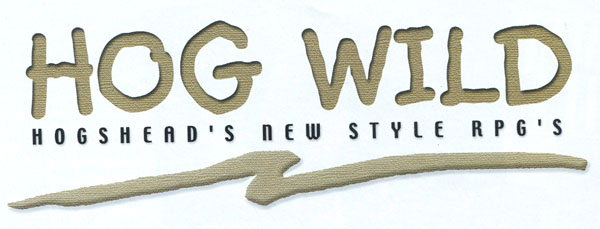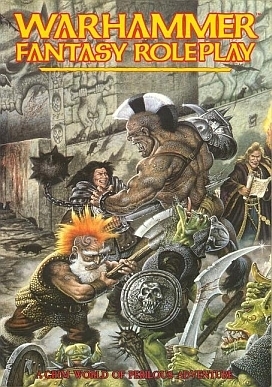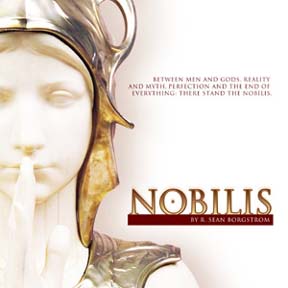This article originally appeared in the March 2001 issue of Games Unplugged.

James Wallis is the man behind Hogshead Publishing – and thus directly responsible for seeing the New Style games, the Warhammer FRP, SLA Industries, and the forthcoming Nobilis into print. He can thus be described as one of the savviest publishers in the roleplaying industry you’re likely to find. He’s also a pretty nice guy (although don’t tell him I said so, it’ll go straight to his head).
What first got you involved in roleplaying?
A guy called Josh Astor, who introduced me to AD&D when I was 14 and bored to death at boarding school. He was the kind of DM who was visibly disappointed when a monster didn’t kill at least one character. He later left the school under a drug-related cloud, and the last time I heard of him was in a story in the Guardian two or three years ago. The headline was “Naked man on hotel roof high on crack”.
Actually, that’s not true. I mean, all that stuff is true, but the person who actually introduced me to the concept of RPGs was Angus McIntyre, who was a year above me at school and played Traveller. He was an enormous influence on me – but we never actually gamed together. Angus is one of the most fiercely original people I know. He’s doing research for Sony these days. See, we’re not all drug-addled fiends.
And what made you think to start your own game company?
Three factors. Firstly Bugtown, an RPG I’d been working on since 1990, was dumped by its publisher, and I wanted to publish it myself. Secondly, Andrew Rilstone and I had started Interactive Fantasy, a magazine about games design, and the first issue sold out in a heartbeat. And thirdly, a friend at Games Workshop told me the rights to Warhammer FRP were up for grabs.
 Of course, it never works out the way you planned it. IF didn’t sell as well as we’d hoped, the trademark-owner pulled the rights on Bugtown, and we got screwed by a distributor and were almost bankrupt four months after launching.
Of course, it never works out the way you planned it. IF didn’t sell as well as we’d hoped, the trademark-owner pulled the rights on Bugtown, and we got screwed by a distributor and were almost bankrupt four months after launching.
But your question was, “Why did I think I should start a games company?” Because I didn’t want to get a proper job, and because I felt I could contribute something to the games industry that wasn’t there already. I still feel that. I am astonished at the lack of innovation in gaming. The market is still stuck in the paradigm created by Gygax and Arneson: one GM, multiple players, character sheets, open-ended narrative, stats or skills, characters improving in terms of abilities rather than as personalities. It’s a paradigm that works, but it shouldn’t be the only one.
Yet here we are in a field where there can be massive arguments about whether it’s even possible to roleplay without dice, and where a game like Ghost Dog – one GM and one player – is considered a major innovation. Is that really all we’ve got to show for 25 years of development? Stupid dice tricks?
That’s why Hogshead exists. To do something new.
You inaugurated the New Style line yourself with the Adventures of Baron Munchausen. What were your guiding thoughts at the time?
“Oh God, don’t let me lose my shirt on this one.”
Munchausen went through a weird birth. I’m a huge fan of the Baron’s stories, and had been trying for years to come up with a core mechanic that could be used on them – the idea being to do the standard RPG-style 200+ page rulebook. I was in the shower one day (JW’s first rule of games design: Ideas in the shower are usually good; ideas on the bog are usually bad) when I suddenly realised that the real essence of the Munchausen stories lies not in their events, but in the way they’re told – and bang, in literally ten seconds, I had the entire game. That was my first thought. My second was “I can’t stretch this to more than half a page of rules. How am I going to be able to publish it?” And then bizarrely I found this manuscript commissioned by my ancestor, John Wallis…
…which is true by the way. The note in the front of Munchausen, I mean. John and Edward Wallis really existed. They published a series of very popular games at the end of the eighteenth century and they were ancestors of mine – not direct-line forbears, but the family tree’s connected. And I didn’t know any of that until I’d been running Hogshead for a couple of years. Game design is hereditary. It’s official.
I had no idea whether Munchausen was going to be any kind of success at all, but it playtested really well and people loved the manuscript, so I decided to just throw it out and see what happened. At that point, it wasn’t a game-plan and the New Style line wasn’t dreamed of. It just seemed like a cool idea and a format that hadn’t been tried before, and I wanted to see how it did.
Everywhere I’ve looked, the games have met with great critical success. Have they been a commercial success for you, too?
I’ve been pleasantly surprised. When we launched Munchausen it looked like we were going to take a total bath on it: advance orders worldwide were for only 300 copies. Then we took it to Gen Con, sold more than 300 copies from our booth there, and the word of mouth started spreading. I owe Ken Hite a lot, actually: He spent the whole of Gen Con ‘98 telling people that they really ought to buy copies. And they did.
Munchausen’s been the runaway success, it’s about to go into its fifth language, but both Puppetland and Violence have done well too, and it’s too early to say definitely on Pantheon but I think that’s going to be huge. The profit margin on $5.95 is pretty slim, but each one does well enough to encourage me to commission more.
Greg Costik— Err… excuse me: Designer X’s Violence and John Tynes’s Power Kill both drew some fan backlash. Some have said they were games which were never meant to be played – so why did you publish them?
Very different reasons, neither of them to do with any kind of “games suck” agenda. Greg actually pitched Violence to me in 1994. When I was looking for a follow-up to Munchausen I asked him if he remembered that, and his response was the first 2000 words of the manuscript. I read it and knew I had to publish it.
 Violence isn’t a great leap forward in game design, but… well… the best analogy I can think of is Memoires, the Situationist book that was bound in coarse sandpaper. You’d put it on your bookshelf, and the sandpaper would rip into the other books – it was a book that destroyed books. Violence is an RPG that destroys RPGs. Read it and you’ll never be able to look at a dungeon-bash the same way again.
Violence isn’t a great leap forward in game design, but… well… the best analogy I can think of is Memoires, the Situationist book that was bound in coarse sandpaper. You’d put it on your bookshelf, and the sandpaper would rip into the other books – it was a book that destroyed books. Violence is an RPG that destroys RPGs. Read it and you’ll never be able to look at a dungeon-bash the same way again.
Power Kill is different, and I have to admit that it was only when it and Violence were at proof-stage that I realised how similar in outlook they are. What attracted me to PK was not its stance on violence, but its amazing design. It’s a completely new type of RPG: a meta-RPG that can fit on top or alongside any conventional RPG. And it’s just three pages long. That blew my mind. There will be other meta-RPGs, as other games writers take Tynes’s design, strip it down, and run with it. That’s New Style: showing that the existing way is not the only way; there are different ways of playing and designing these games. Violence does that too.
You’ve been extremely successful attracting some of the premier talent of the industry to the New Style line. What’s your secret?
Nepotism.
Actually I think – I hope – that designers are taking each New Style title as a thrown gauntlet: “Here’s something even cooler. Beat this.” Pantheon came about because Robin (Laws) saw John (Tynes) fit two complete RPGs into 24 pages and wanted to top that. If that provokes someone into thinking they can do eight RPGs in 24 pages, and so long as those eight RPGs don’t suck, then we’d love to publish them.
Games designers, pretty much by definition, have radically weird ideas for new games. There are three things they can do with them: forget them, stick them on the web, or bring them to Hogshead. If we think the idea’s as cool as they do, we’ll give them money and publish it. Ultimately I’m enormously flattered that Greg, John and Robin let me publish their ideas. I get a huge kick out of seeing the names of people whose work I respect on the front of a Hogshead book. But New Style is not reserved for big-name designers. If John Q Newcomer has an idea for the next Munchausen in his shower tomorrow, I want to publish it.
Where do you plan to go from here?
One word: Nobilis. Nobilis is the most amazing RPG I’ve seen in years. The first edition took my breath away. As I write we’re recreating the game for its second edition into something that I  sincerely believe will change the way that a lot of people think about RPGs. It’s going to be astonishing. Right now I can’t think of any RPGs that I’d call “literary” or “beautiful”, and very few I’d call “intelligent” or “well-written”. Nobilis is all those.
sincerely believe will change the way that a lot of people think about RPGs. It’s going to be astonishing. Right now I can’t think of any RPGs that I’d call “literary” or “beautiful”, and very few I’d call “intelligent” or “well-written”. Nobilis is all those.
We’re going to keep on with the Warhammer and SLA Industries releases: We may want to push the boundaries, but we haven’t forgotten our roots. We’ve got a translation of a terrific French game, Bloodlust, waiting in the wings – it’s a Croc design (best known over here for creating In Nomine). Derek Pearcy, who did the American edition of InNom for SJG, is developing it for us. It’s influenced by Conan, Elric, Frazetta and way too much vin de table.
Beyond that… we’re not saying just yet. But we have plans. Oh man, yes.












Of course, the Bloodlust translation was never released, and Wallis’ other plans never materialized. I think Nobilis was their last major product before they shut down.
My copy of Nobilis 2E is one of my proudest RPG aquisitions, and I’ve wondered for years what series of events could possibly result in something like that seeing print.
These articles are a really cool window into one of the strangest chapters of indie RPG history. Thanks for sharing them!